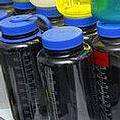 人們在運動或登山時常會用各類彩色透明塑膠瓶攜帶飲料,最新的科學研究顯示,如果裝入熱的液體,將會釋放出擾亂荷爾蒙的化學物質。
人們在運動或登山時常會用各類彩色透明塑膠瓶攜帶飲料,最新的科學研究顯示,如果裝入熱的液體,將會釋放出擾亂荷爾蒙的化學物質。
根據辛辛那提大學的科學家的研究發現,無論水瓶的新舊,這種聚碳酸酯(polycarbonate,PC)的材質遇到滾燙的熱水將會放出擾亂內分泌的化學物質酚甲烷(bisphenol-A),又稱BPA。
這種化學物質常見於各種用途,包括可重複使用的水瓶、食物收藏罐的襯裡、水管接著劑、牙醫用的溝隙充填劑等。在動物實驗中,此物質會對生殖與腦部發育造成影響。
貝屈博士(Scott Belcher)與他的研究團隊發現,當聚碳酸酯水瓶短暫接觸滾燙的熱水,酚甲烷的釋放速率將會增加55倍。先前的研究也顯示,重複摩擦、刷洗與烹煮嬰兒用的聚碳酸酯瓶會釋放酚甲烷。這讓我們瞭解了酚甲烷能夠從各式聚碳酸酯塑膠中被釋放。
貝屈博士說:「這研究的靈感來自於攀岩團體的疑問,於是我們根據消費者的習慣對這些塑膠水瓶做測試,而結果顯示,唯一對釋放濃度造成影響的因素是液體溫度,而使用九年的水瓶與新的水瓶釋放的酚甲烷數量相當。」
「我們發現無論瓶子的新舊,在冷水或是溫水中,酚甲烷的釋放量與速率都相同。但是一旦水瓶接觸了滾燙熱水,酚甲烷的釋放速率馬上增加為15到55倍。」
貝屈博士強調,雖然目前對於酚甲烷濃度多高才有害人體尚無共識,但他建議消費者慎思長期暴露在此物質下對健康的影響。他說:「酚甲烷是人類接觸的一種類似雌激素的化學物質,這類物質包括了黃豆中有益的的天然植物雌激素,而科學家還在嘗試瞭解這些內分泌干擾素在交互作用下如何影響人體健康。」「但越來越多的證據顯示這些物質多半對健康有負面的影響。」
此研究由美國國家環境衛生科學研究院資助,發表於最新一期「毒理學通訊」期刊。
The clear, colorful plastic bottles often used by athletes and hikers to carry liquids release a chemical known to disrupt hormone function if the liquids they contain are hot, new research has confirmed.
The endocrine disrupting chemical bisphenol-A, or BPA, is released when polycarbonate plastic is exposed to boiling water, according to University of Cincinnati scientists, whether the bottle is new or old.
The chemical, which is widely used in products such as reusable water bottles, food can linings, water pipes and dental sealants, has been shown to affect reproduction and brain development in animal studies.
Scott Belcher, PhD, and his team found when the same new and used polycarbonate drinking bottles were briefly exposed to boiling hot water, BPA was released up to 55 times more rapidly. "Previous studies have shown that if you repeatedly scrub, dish wash and boil polycarbonate baby bottles, they release BPA. That tells us that BPA can migrate from various polycarbonate plastics,"
"Inspired by questions from the climbing community, we went directly to tests based on how consumers use these plastic water bottles and showed that the only big difference in exposure levels revolved around liquid temperature," Belcher said. "Bottles used for up to nine years released the same amount of BPA as new bottles."
The researchers found that the amount of BPA released from new and used polycarbonate drinking bottles was the same, both in quantity and speed of release, into cool or temperate water. But once the bottles were exposed to boiling water the speed of BPA release was 15 to 55 times faster, explains Belcher.
Belcher stresses that it is still unclear what level of BPA is harmful to humans, but he urges consumers to think about how cumulative environmental exposures might harm their health. "BPA is just one of many estrogen-like chemicals people are exposed to, and scientists are still trying to figure out how these endocrine disruptors - including natural phyto-estrogens from soy which are often considered healthy - collectively impact human health," he says. "But a growing body of scientific evidence suggests it might be at the cost of your health."
The study was funded by a National Institute of Environmental Health Sciences grant. It is published in today's issue of the journal "Toxicology Letters."


